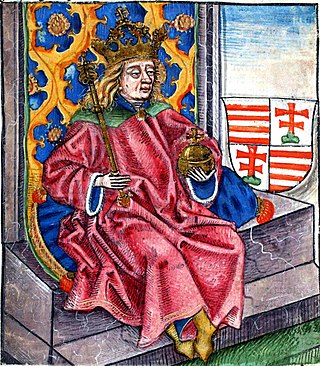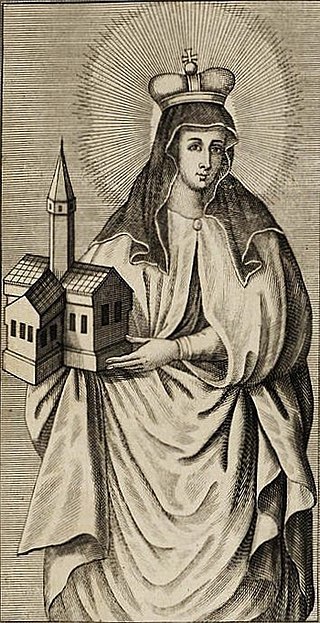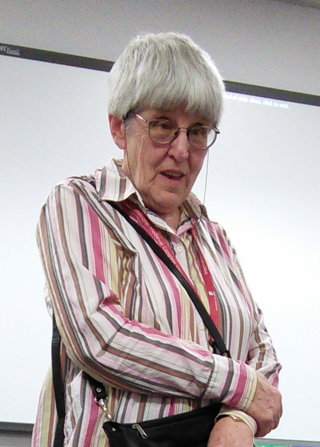
Stephen I, also known as King Saint Stephen, was the last Grand Prince of the Hungarians between 997 and 1000 or 1001, and the first King of Hungary from 1000 or 1001, until his death in 1038, also known for being the first King to receive the title Apostolic Majesty by Pope Clement XIII. The year of his birth is uncertain, but many details of his life suggest that he was born in, or after, 975, in Esztergom. He was given the pagan name Vajk at birth, but the date of his baptism is unknown. He was the only son of Grand Prince Géza and his wife, Sarolt, who was descended from a prominent family of gyulas. Although both of his parents were baptized, Stephen was the first member of his family to become a devout Christian. He married Gisela of Bavaria, a scion of the imperial Ottonian dynasty.

Stephen V was King of Hungary and Croatia between 1270 and 1272, and Duke of Styria from 1258 to 1260. He was the oldest son of King Béla IV and Maria Laskarina. King Béla had his son crowned king at the age of six and appointed him Duke of Slavonia. Still a child, Stephen married Elizabeth, a daughter of a chieftain of the Cumans whom his father settled in the Great Hungarian Plain.

Ladislaus I, also known as Saint Ladislas, was King of Hungary from 1077 and King of Croatia from 1091. He was the second son of King Béla I of Hungary and Richeza of Poland. After Béla's death in 1063, Ladislaus and his elder brother, Géza, acknowledged their cousin Solomon as the lawful king in exchange for receiving their father's former duchy, which included one-third of the kingdom. They cooperated with Solomon for the next decade. Ladislaus's most popular legend, which narrates his fight with a "Cuman" who abducted a Hungarian girl, is connected to this period. The brothers' relationship with Solomon deteriorated in the early 1070s, and they rebelled against him. Géza was proclaimed king in 1074, but Solomon maintained control of the western regions of his kingdom. During Géza's reign, Ladislaus was his brother's most influential adviser.

Ottokar I was Duke of Bohemia periodically beginning in 1192, then acquired the title of King of Bohemia, first in 1198 from Philip of Swabia, later in 1203 from Otto IV of Brunswick and in 1212 from Frederick II. He was one of the most eminent members of the Přemyslid dynasty.
The Lesser Key of Solomon, also known as Lemegeton Clavicula Salomonis or simply Lemegeton, is an anonymous grimoire on demonology. It was compiled in the mid-17th century, mostly from materials a couple of centuries older. It is divided into five books—the Ars Goetia, Ars Theurgia-Goetia, Ars Paulina, Ars Almadel, and Ars Notoria.
In demonology, Halphas is the thirty-eighth demon in the Ars Goetia in the Lesser Key of Solomon, ranked as an earl.

Béla IV was King of Hungary and Croatia between 1235 and 1270, and Duke of Styria from 1254 to 1258. As the oldest son of King Andrew II, he was crowned upon the initiative of a group of influential noblemen in his father's lifetime in 1214. His father, who strongly opposed Béla's coronation, refused to give him a province to rule until 1220. In this year, Béla was appointed Duke of Slavonia, also with jurisdiction in Croatia and Dalmatia. Around the same time, Béla married Maria, a daughter of Theodore I Laskaris, Emperor of Nicaea. From 1226, he governed Transylvania as duke. He supported Christian missions among the pagan Cumans who dwelled in the plains to the east of his province. Some Cuman chieftains acknowledged his suzerainty and he adopted the title of King of Cumania in 1233. King Andrew died on 21 September 1235 and Béla succeeded him. He attempted to restore royal authority, which had diminished under his father. For this purpose, he revised his predecessors' land grants and reclaimed former royal estates, causing discontent among the noblemen and the prelates.

Anne of Bohemia, a member of the Přemyslid dynasty, was Duchess of Silesia and High Duchess of Poland from 1238 to 1241, by her marriage to the Piast ruler Henry II the Pious. She was celebrated by the community of Franciscan nuns at St Clara of Prague Abbey in Wrocław as their founder and patron.

Maria Laskarina was a Greek Queen consort of Hungary by marriage to Béla IV of Hungary. She was the daughter of Theodore I Laskaris and Anna Komnena Angelina.

Éva Pócs is a Hungarian ethnographer and folklorist.

Kinga of Poland is a saint in the Catholic Church and patroness of Poland and Lithuania.

Hermann II was the Landgrave of Thuringia and the son of Louis IV, Landgrave of Thuringia, and Saint Elizabeth of Hungary.
The Vainakh peoples of the North Caucasus were Islamised comparatively late, during the early modern period, and Amjad Jaimoukha (2005) proposes to reconstruct some of the elements of their pre-Islamic religion and mythology, including traces of ancestor worship and funerary cults. The Nakh peoples, like many other peoples of the North Caucasus such as Circassians and Ossetians, practised tree worship, and believed that trees were the abodes of spirits. Vainakh peoples developed many rituals to serve particular kinds of trees. The pear tree held a special place in the faith of Vainakhs.

Anna of Schweidnitz (Świdnica) was Queen of Bohemia, German Queen, and Empress of the Holy Roman Empire. She was the third wife of Emperor Charles IV.
Solobung Yubin, otherwise called Uhaa Solbon, is the "spirit of the evening and morning stars -- Venus (Solbon)." Or else, Solbon is Venus simply as "evening star". This name, defined as the "shepherd of heaven", is transcribed Ζὀλβων in Byzantine records. In Korean, it is variously written /čolbon/ (卒本) or /solbon/ (率本).
Atai Ulaan, in Buryat mythology, is described as the leader of 44 Tenger (sky-gods) of the eastern skies, he is the leader of an army consisting of 6,666 soldiers.

Mongolian shamanism, more broadly called the Mongolian folk religion, or occasionally Tengerism, refers to the animistic and shamanic ethnic religion that has been practiced in Mongolia and its surrounding areas at least since the age of recorded history. In the earliest known stages it was intricately tied to all other aspects of social life and to the tribal organization of Mongolian society. Along the way, it has become influenced by and mingled with Buddhism. During the socialist years of the twentieth century, it was heavily repressed, but has since made a comeback.

The "culture of popular laughter" is a cultural-historical term coined by the literary critic Mikhail Bakhtin in his book Rabelais and His World (1965). This studied popular culture in Renaissance Europe through the themes of François Rabelais' book Gargantua and Pantagruel (1532–64). The idea of the culture of popular laughter combines two literary ideas developed by Bakhtin in the same work: "grotesque realism" and "carnivalesque" which examined, respectively, the celebration of primary needs and the idea of carnival in which social norms were subverted.
Mergen is a Turkic deity of abundance and wisdom. Mergen is often depicted with a bow and arrow in one hand. Other important symbols include a white horse and the color white. He is associated with profundity and depicted as a strong and powerful god. Mergen is the son of Kayra and the brother of Ulgan, and lives on the seventh floor of sky. He was portrayed as a young man with a helmet and a bow riding on a white horse. Mergen symbolizes intelligence and thought.

Gábor Klaniczay is professor of Medieval Studies at the Department of Medieval Studies of the Central European University, Budapest/Vienna. He is also titulary professor at the Department of Medieval History at the Faculty of Humanities of the Eötvös Loránd University, Budapest. He is corresponding fellow of the American Academy of Arts and Sciences.